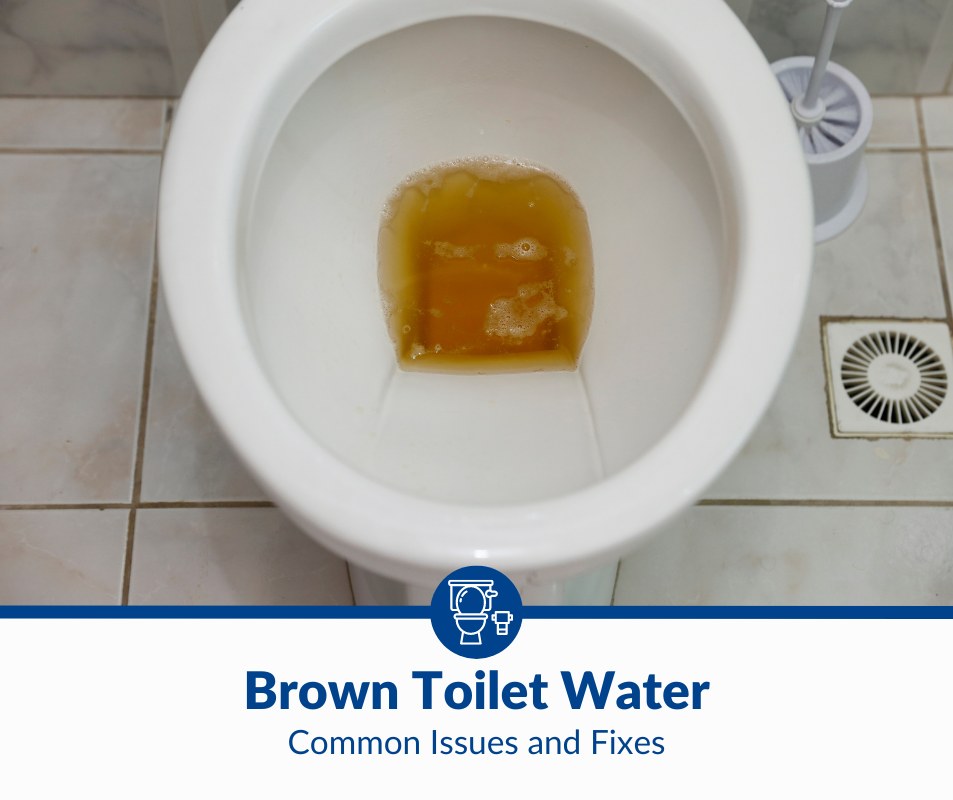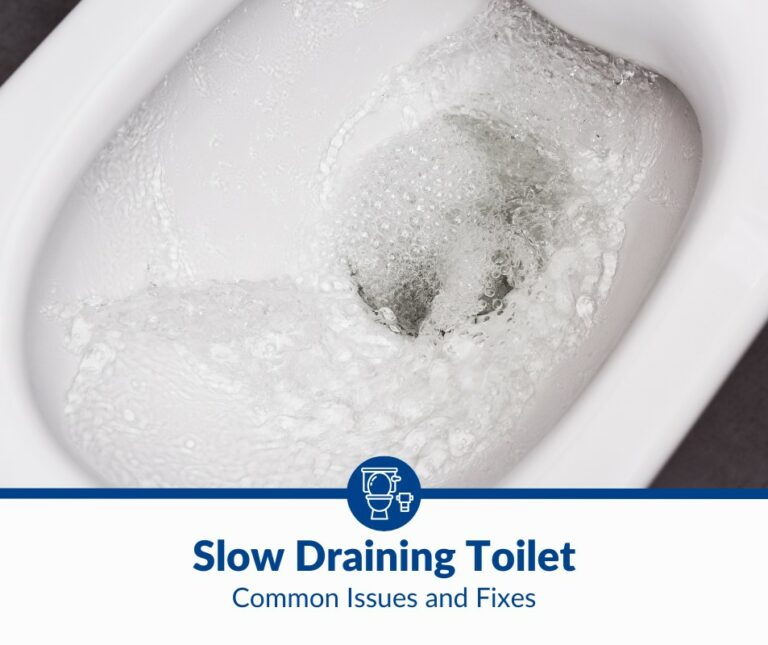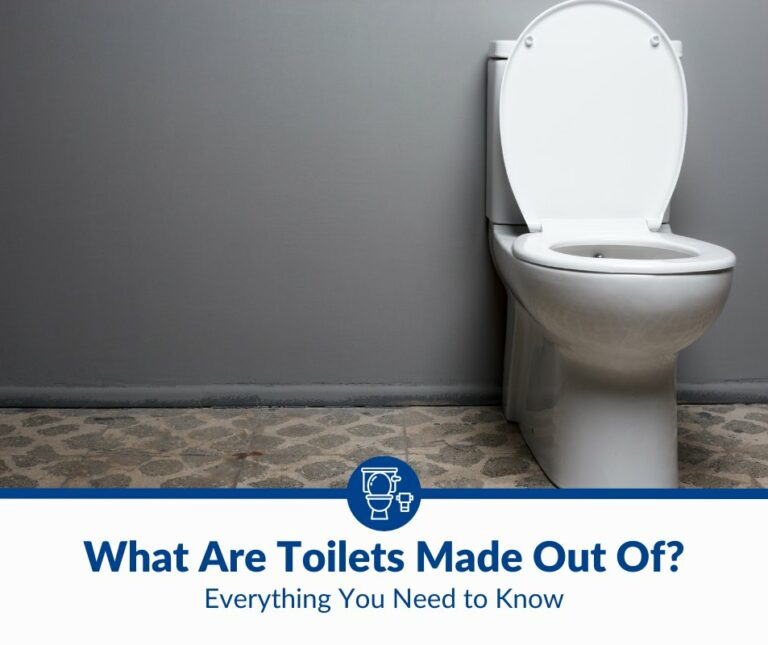Brown Toilet Water: Why Is My Toilet Water Brown?
Brown toilet water can be a perplexing sight, especially if you don’t know what could be causing it. Whether you’ve noticed a slight discoloration or a full-on mud-like hue, it’s a good idea to take a closer look and figure out what’s going on.
Brown toilet water can be caused by a variety of things, ranging from simple mineral buildup to high iron content in the water supply. More serious issues can be anything from a corroded pipe to a broken septic tank.
Whether it’s cleaning the pipes or identifying the issue and taking the appropriate action. In this article, we’ll look at the common causes of brown toilet water and the steps you can take to resolve the issue and restore your toilet to its normal functioning.
8 Causes of Brown Toilet Water
Knowing the causes of brown toilet water can be important if you want to keep your home’s plumbing system in top condition. Brown toilet water is usually caused by rust, which can occur when the water sits in old pipes for a long time.
Other causes include:
- A buildup of rust and sediment in the pipes or other components
- Infrequent or ineffective flushing
- Flushing of large objects
- Plumbing issues
- Excessive iron buildup
- Unclean toilet
- Bacteria in the pipes
If your water is contaminated with bacteria, it can be a sign of a bigger problem with the plumbing system. Also, if you have an older toilet, you might find that the accumulation of sediment in the pipes has caused the toilet water to turn brown.
Whatever the cause of your brown toilet water, it’s important to get it checked out by a professional plumber to ensure that your home is safe and the plumbing system is functioning properly.
In the meantime, let’s take a look at some of the causes of brown toilet water so you can determine if you can fix it yourself or if you need a professional.
1. Rusted Toilet Fixtures
Rusted toilet fixtures can happen when water with high iron content is used in the toilet, resulting in rusty pipes and other parts.
Rust can occur in many places, from the toilet’s metal fill valve to its steel flush valve. Even rusted flapper valves or metal float balls can cause discolored water. These rust particles can be suspended in the water, giving it a brown color.
The rust may also settle at the bottom of the tank or bowl, giving the water a cloudy or muddy appearance. In extreme cases, the rust may even clog the toilet or lead to a weak flush.
To prevent rust, it’s important to check for any corrosion or wear-and-tear on the toilet components. Replace any rusted parts as soon as possible to avoid more serious problems down the line.
How To Fix
Rust can be a huge problem for toilet components. If left unchecked, it can cause serious damage and lead to expensive repair costs. Fortunately, there are some steps you can take to prevent and fix rusted toilet components.
First, it’s important to make sure the area is properly ventilated. This will help prevent the spread of any rust particles.
- Use a brush to remove any visible rust. You can also use a rust remover solution to help loosen stubborn rust.
- Once the rust has been removed, you can use a high-grade primer and paint to protect the surface and keep it from rusting again.
- Finally, you can use a sealant to keep moisture out and further protect the surface from rust.
2. Rusted Pipes
Rust in your toilet pipes is a common problem that can cause brown toilet water and other plumbing issues. But what causes this rust in the first place? The answer lies in the water itself.
The water that runs through the pipes contains iron, and when the iron reacts with oxygen and moisture, it forms rust. This rust can build up over time, clogging the pipes and causing problems.
The problem is compounded by the fact that the pipes are often made of outdated materials, which can be prone to rust.
How To Fix
Rusted toilet pipes can be a real nuisance. If left unchecked, the rust can cause your toilet water to turn a nasty brown color. This is not only unpleasant to look at, but it can also lead to health problems if ingested. Thankfully, there are a few ways you can avoid rust in your toilet pipes.
- First, make sure the water coming into your home is free from iron. If it isn’t, consider adding a water filter to remove the iron from the water.
- You can also add a rust inhibitor to the water, which will slow down the rusting process.
- Make sure to keep your pipes clean and free of debris, such as hair and soap scum. This will help to prevent the buildup of rust and keep your toilet water nice and clear.
- Finally, regular maintenance of the pipes can help prevent rust from forming in the first place.
If the above DIY steps don’t work, consider the fact that you might have to change out your old pipes for new ones as soon as possible.
3. Waste Build-Up
The cause of brown toilet water can sometimes be the buildup of waste and sediment in the pipes of your toilet. This can lead to clogged toilets, discoloration, unpleasant odors, and slow draining.
If your water isn’t flushing completely, it could be due to a few different causes:
The first possibility is the accumulation of sediment in the toilet tank. Over time, small particles can settle at the bottom of the tank, clogging the pipes and preventing the water from draining properly. If this is the case, you’ll need to clean out the tank and flush it several times to get rid of the debris.
Another cause could be a blockage in the pipes. If you suspect this is the issue, you should call a plumber right away. They can use specialized tools to locate and remove any blockages in the pipes.
Lastly, the problem could be caused by tree roots growing into the pipes. This is a more serious issue that requires the help of a professional.
But no matter what the cause, you should take action to fix the problem as soon as possible to avoid any further damage.
How To Fix
To prevent this from happening, there are several steps you can take. But the best way to prevent this from happening is to ensure that you flush the toilet regularly and don’t flush anything other than toilet paper.
Then ensure that all wastewater is disposed of properly. This includes not flushing items like:
- Paper towels
- Wet wipes
- Sanitary towels
- Cotton balls
- Other non-biodegradable items
You should also limit the use of chemical cleaners, as they can build up over time and cause damage to the pipes.
Additionally, it’s important to regularly inspect your plumbing system for any leaks or blockages. If any are found, they should be fixed as soon as possible to prevent the build-up of waste.
4. Build-Up of Mineral Deposits
The build-up of mineral deposits in toilets is a common issue and can be caused by several things. The most common cause is the presence of iron, calcium, and other minerals in the water.
When water flows through pipes, it picks up minerals along the way. These minerals can build up in your toilet over time, making the water appear brown. The minerals can also clog the pipes, leading to plumbing problems.
How To Fix
The best way to prevent this is to have your water tested regularly and to use distilled or filtered water if possible. If you already have a build-up of minerals, you can use a toilet descaler to break them down. This will help clear the water and keep your toilet clean and functioning properly.
Finally, make sure you use a water softener. Water softeners help reduce the number of hard minerals in your water, which can help keep your toilet and pipes clear of mineral deposits.
5. Damaged Water Pump
A toilet water pump is a device that helps to move water from one point to another. It is most commonly used in bathrooms to pump water from a tank to the toilet bowl for flushing. This helps to create a steady flow of water that is strong enough to push the waste through the pipes and out of the toilet.
If you notice that your toilet water has taken on a brown tint, it could be that the water pump is damaged and needs to be replaced. When the pump is damaged, it will stop pushing water, and the tank will not fill up properly.
This can cause the water to become stagnant and contaminated, leading to a brown color.
How To Fix
If you have a damaged toilet water pump, the first step is to check the power source. Make sure the pump is getting the required voltage and is securely plugged into a power outlet.
- Once the power source has been verified, the next step is to check the pump itself. If the pump is making noise or vibrating, the motor may need to be replaced.
- If the pump is leaking, then the gasket or seal may need to be fixed. In some cases, the motor or impeller may need to be replaced or repaired.
- If the pump is clogged, then it will need to be cleaned out. You may need to use a wrench to loosen the pump and clean it off with a damp cloth.
Once the pump is cleaned and all the components are securely attached, turn on the power and check to see if the pump is working properly.
If it is still not working, it may be best to call a professional plumber to look at it. This is a job best left to a professional plumber, as it requires special tools and knowledge to ensure it is done correctly.
6. Damaged Water Well
A damaged water well can lead to serious problems for homeowners. While some of the causes of a damaged well are preventable, most of them are difficult to predict.
One of the most common causes of a damaged well is the inability of the pump to draw enough water from the well. If the pump is too small or is not powerful enough, it can damage the well.
Another cause of a damaged well is corrosion or deterioration of the components in the well. If the casing or pipe leading to the well is made of metal, corrosion can occur over time due to exposure to water and oxygen.
Finally, a damaged well may be the result of an earthquake or other seismic event. If the soil surrounding the well is disturbed, it can cause the well to collapse and become damaged.
When a water well is damaged, it can allow surface water, silt, and sediment to seep into the well water. Damage can also cause excessive amounts of sediment to enter the water supply, clogging up the pipes and settling at the bottom of the well.
This, in turn, causes the water to become discolored. In addition to being unsightly, this brown water can also have a bad odor.
Additionally, the damaged well may also have been contaminated by chemicals or other hazardous materials, which can cause further discoloration and smell.
How To Fix
If your toilet water is brown, the first thing you should do is check the water quality in your well.
If it’s a minor issue, you may be able to fix it yourself.
But if the damage is more extensive, you should get in touch with a professional. A qualified technician can determine the cause of the discoloration and recommend the best course of action to take to fix the damaged well and restore the water to its original condition.
7. Old Toilet System
Toilet systems can become inefficient with age, leading to the build-up of sediment, rust, and other debris in the pipes. This can cause the water to become discolored, turning it into a murky brown.
If you’re noticing brown toilet water and you have an old system, it could indicate that your toilet is worn out from heavy use and needs repair or replacement.
The brown color is from rust or sediment that can collect in the tank or bowl when the toilet isn’t serviced regularly. You may also notice slow drainage, clogging, and a decrease in water pressure.
How To Fix
If your toilet water is suddenly brown, it’s a good idea to get it checked out by a plumbing professional. They can inspect your toilet system and pipes to determine the cause and suggest a solution.
In some cases, the problem may be an easy fix, like replacing a corroded pipe or adjusting the water pressure.
But if the system is too old, it might need to be replaced altogether. If this is the case, it’s best to get a new model that is designed for efficiency so you don’t have to worry about brown toilet water again.
8. Unclean Toilet
When it comes to the cleanliness of your toilet, it can mean the difference between clear and brown water. Toilet water should always be crystal clear, so if it turns brown it could be an indication of an unclean bowl.
The brown coloration is usually caused by a buildup of mineral deposits, rust, or even dirtiness from the inside of the bowl and tank. If you’re wondering why your toilet water is turning brown, it’s likely because you haven’t been cleaning it regularly.
Regular cleaning is essential to keeping your toilet water crystal clear. This means scrubbing the inside of the bowl and tank, using a toilet brush to reach deep into the crevices, and using a toilet cleaner to help remove any build-up.
Additionally, it’s important to flush your toilet at least once a day to help keep it clean. So if you’re seeing brown water in your toilet, be sure to give it a good cleaning and get it back to sparkling clean status!
How To Fix
Cleaning a toilet may not be the most pleasant of tasks, but it is necessary to keep a bathroom sanitary and germ-free. Fortunately, it’s not as complicated as it might seem. With just a few simple steps, you can make your toilet sparkle! The first step is to gather your supplies.
You’ll need:
- Toilet bowl brush
- Toilet cleaning solution
- Rubber gloves
- Rag
Once you have everything you need, it’s time to start cleaning:
- Use the toilet brush to scrub the inside of the bowl and the tank
- Then spray the inside with the cleaning solution
- Use the rag to wipe the inside of the bowl and tank
- Finally, use a damp cloth to wipe off any remaining residue, and you’re done!
Final Thoughts
Brown toilet water can be a nuisance, but with the right diagnosis and treatment, you can get your toilet back up and running like normal. Common causes include:
- Rusted toilet fixtures
- Rusted pipes
- Waste buildup
- Build-up of mineral deposits
- Damaged water pump
- Damaged water well
- Old toilet system
- Unclean toilet
If you’re having an ongoing issue with brown toilet water, it’s best to contact a qualified plumber to inspect your pipes and determine the cause. Taking action quickly can save you from any major plumbing issues in the future.







